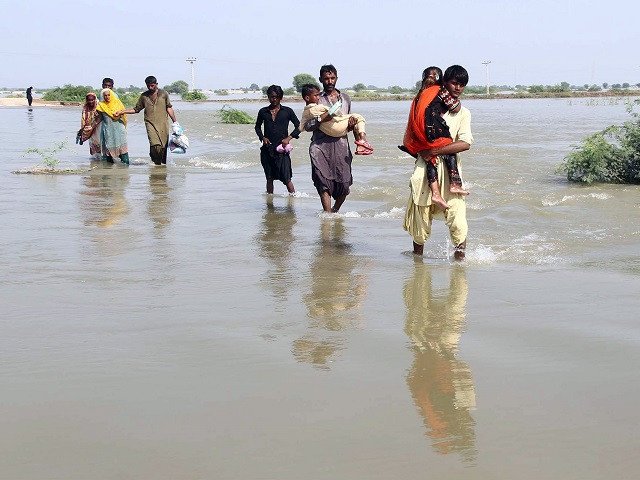Fresh spell of rains pummel lower Sindh; CM Shah takes boat ride to ancestral home

HYDERABAD: The residents of Dadu must have heaved a sigh of relief on Monday as water levels surrounding the city began to recede, but a fresh spell of rain increased problems for the people in the flood-affected areas of Hyderabad and Mirpurkhas divisions.
Dadu and Bhan Syedabad, which faced grave danger of flooding from the rampaging Manchar lake for the past few days, witnessed with great relief that the water level outside the protective ring embankments dropped a bit.
However, the drop in water pressure on the two towns of the Dadu district was made possible after several cuts were given to the Indus Highway and the Larkana-Sehwan embankment to divert the water towards the River Indus.
The authorities increased the water discharge in the Indus after its level fell by 19,500 cusecs in the last 12 hours. The Indus recorded 607,800 cusecs upstream at 6 am Monday, which dropped to 588,300 cusecs at 6 pm after attaining a peak of over 626,000 cusecs.
A two-foot fall was recorded at the ring bund around the Mehar taluka and around 1.5 feet at Johi town. Manchar, the country’s largest freshwater lake which has been overflowing for the past few weeks, also saw a slight reduction in its level.
Although the major urban centres of Dadu and Jamshoro districts appear to be past the flood threat, the rural parts of both the districts, like most other districts of Sindh, are still under eight to 10 feet of water.
“Some 10 union councils of Sehwan have been inundated in water from cuts [and breaches] in Manchar,” Sindh Chief Minister Syed Murad Ali Shah, who visited Sehwan and his native village Wahar by boat on Monday, told the local media.
“If we had not given the cuts, the lake [which had swelled over 10 times its original size] would have breached itself and then the devastation would have been far worse,” Shah said. He added that Manchar dropped after the authorities cut the lake’s banks at five places.
Responding to a question, the chief minister announced that the army had successfully protected the National Transmission and Dispatch Company’s (NTDC) grid station in Dadu from inundation.
Shah took aerial view of Manchar, Sehwan and adjoining areas. “There is no threat of flooding to Dadu city,” he said. However, he added that relief and the drainage of rainwater still remained top priorities of the government.
“I told the UN’s general secretary [Antonio Guterres] that we don’t need support in the form of cash but we need things,” Shah said, while responding to a question about the government’s relief efforts in the flood-hit areas.
Shah also visited a relief camp at Arhal distributary, near Sehwan. He later took an eventful boat ride to his ancestral village. En route to Wahar, the chief minister also stopped by some other flooded villages.
On the way, the chief minister’s boat stopped either because of some technical fault or because of its refuelling requirement. However, Shah took another boat to continue his journey. Reportedly, the chief minister also changed boats, while returning from Wahar.
Later at the circuit house in Sehwan, Shah held a meeting in which he reportedly tried to reconcile the differences between Pakistan Peoples Party’s (PPP) National Assembly member Sikandar Rahupoto and Jamshoro Deputy Commissioner Capt (retd) Fariduddin Mustafa.
More rains
A fresh spell of rain increased the miseries of the people, particularly in the already flooded rural areas of the Hyderabad and Mirpurkhas divisions. An evacuation alert was issued for the low-lying areas of Naukot, Mirpurkhas, where the Left Bank Outfall Drain (LBOD) overflowed.
The Pakistan Meteorological Department had forecasted the rain for September 13. The PMD recorded 26 millimetres downpour in Mirpurkhas district, 22mm in Tharparkar, 19mm in Thatta and 11mm in Badin by Monday evening.
The irrigation officials, protected by the police, tried to give a cut to the LBOD’s spinal drain in Badin district’s Kaloi area but the local people resisted, arguing that the water level would rise in their inundated villages.
Schools closed
In Naushehroferoze district the government and private schools remained closed on Monday, as the summer vacations were extended. The deputy commissioner directed the school managements to keep the schools closed until the condition of the buildings were checked.
Courtesy : Express Tribune